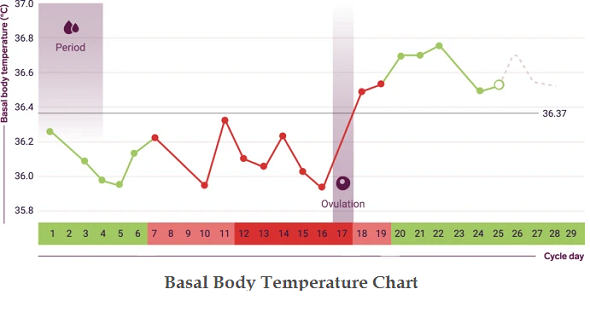What is the Menstrual Cycle?
The series of changes a woman’s body goes through every month in preparation for the possibility of pregnancy is known as the menstrual cycle. It is usually about 28-30 days in length, but it can range from 21 to 35 days in adults and 21 to 45 days in young teens. The cycle is divided into several phases, each marked by specific hormonal changes and physiological changes..
What are the Phases of the Menstrual Cycle?
The menstrual cycle consists of four main phases:
- Menstrual Phase
- Follicular Phase
- Ovulation
- Luteal Phase

The Menstrual Phase
Duration: The menstrual phase lasts from Day 1 to Day 5 of the menstrual cycle. The first day of bleeding is the Day 1 of the cycle.
The menstrual phase starts on the first day of your period and normally lasts for about 3 to 7 days, the average being 5 days. This time is characterized by the flow of blood and tissues through the vagina. Bleeding occurs when the inner lining of the uterus (endometrium) is shed in bits and pieces from the uterus.
The levels of the hormones, Estrogen and Progesterone, are at their lowest during this phase.
Signs and Symptoms of the Menstrual Phase:
Blood Loss: It is normal to lose about 30-40 ml of blood in each cycle. Menstrual bleeding is considered heavy if the blood loss is more than 80 ml. Most regular sized pads or tampons hold about 5 ml of blood ( a teaspoon) and extra-absorbent pads hold about 10 ml.
Menstrual Cramps: Many women suffer from menstrual cramps which may range from mild to quite severe. The cramps occur due to the secretion of prostaglandins in the uterine muscle. It is more common in younger girls and is very less in older women.
Fatigue: Low hormone levels can make you feel more tired and lethargic. Mood swings are also common.
The Follicular Phase
Duration: The follicular phase lasts from Day 1 to Day 13 of the menstrual cycle.
The follicular phase overlaps with the menstrual phase in the first few days but continues even after your period ends. This phase is crucial for preparing your body for potential pregnancy.
Each ovary contains a number of small premature follicles known as the Primordian follicles. Under the influence of the hormone FSH ( Follicle Stimulating Hormone) secreted from the pituitary gland, some of these follicles start to grow at around Day 3 of the periods. This group of follicles is known as a ‘cohort’. Primary follicles develop into secondary follicles, and then into tertiary, or Graafian follicles. A Graafian follicle is a small, fluid-filled sac in the ovary that contains an egg or ovum .
The follicles develop at the same rate initially but around day 7, one of the follicles begin to become larger than the others and grows faster. This is the Dominant follicle and is the one which ruptures during Ovulation.
The ovum also matures together with the follicle and is released when the follicle ruptures at the time of ovulation at around Day 14 of the menstrual cycle.
Hormones of the Follicular Phase:
FSH: One of the active hormones in the follicular phase is the Follicle Stimulating Hormone (FSH) released by the pituitary gland. FSH stimulates the growth of follicles in the ovaries and its level increases gradually until it peaks at around Day 12 to Day 14 of the menstrual cycle.
Estrogen: Estrogen is secreted by the developing follicles. Its level begins to rise at around Day 4- 7 and increases steadily until the day of ovulation. It falls after ovulation. Estrogen causes thickening and proliferation of the endometrium. So, the follicular phase is also called the Proliferative phase of menstruation.
Chances of pregnancy are highest if sexual intercourse occurs in the later part of the follicular phase at around the time of ovulation.
Signs and Symptoms of the Follicular Phase:
Energy Levels: Rising estrogen levels can make you might feel more energetic and positive. You will feel more happy and optimistic. The sex drive may also rise since the chances of pregnancy is highest at this time.
Body Temperature: Estrogen is a thermogenic hormone – meaning that it causes the resting body temperature to rise. The body temperature should be taken in the morning, while you are still at rest, to get an accurate result. The temperature increases steadily until it peaks at the time of ovulation. At this time, it dips a little due to the decrease in estrogen level and then rises again. It remains high in the luteal phase due to progesterone and then drops abruptly just before the period. If pregnancy occurs, it continues to remain high throughout pregnancy.
Cervical Mucus: The cervical glands are stimulated by estrogen. So, you may notice an increase in the amount of cervical mucus. At around the time of ovulation, the cervical mucus may be abundant, clear and watery and more stretchable than usual.
Skin and Mood: Many women notice clearer skin and an improved mood during this phase.
The Ovulatory Phase
Duration: Ovulation occurs at around Day 14 (in a 28-day cycle) or Day 15- 16 in a 30 day cycle.
Ovulation is the process of release of a mature egg from one of your ovaries. This is the most fertile period of your cycle and usually occurs mid-cycle, but it can vary.
Hormones of the Ovulatory Phase:
Leuteinising Hormone (LH): LH is secreted from the pituitary gland in response to high estrogen levels. A high LH level triggers ovulation from the ovary. LH levels peak about 24-36 hours before ovulation and then decreases abruptly after ovulation. LH test is an important test for ovulation.
Estrogen: Estrogen levels are also at their highest just before ovulation.
Signs and Symptoms of Ovulation:
There are seven important signs of ovulation, all of which may not occur in all women and in every month.
Change in Cervical Mucus: Your cervical mucus becomes very slippery and stretchy at this time. It is clear and watery, similar to raw egg whites. It can stretch to about 2-4 cms between the fingers.
Cramping : Some women experience mild pelvic or abdominal pain o one side of the abdomen. This pain or discomfort is known as mittelschmerz. It is a dull, achy pain, which increases when walking. It remains for about 3-4 days and then decreases spontaneously.
Rise in Basal Body Temperature: the resting body temperature rises by at least 1 degree during ovulation and remains at a high level till the period occurs.
Increased Libido: The sex drive may increase, possibly due to the high estrogen levels.
Breast tenderness: Some women may complain of tenderness and fullness of the breast. This is also due to fluid retention in the breast under the influence of estrogen.
Positive ovulation test : Ovulation tests, which tests for the level of LH becomes positive. This is a urine test. Sexual intercourse at this time increases the chances of a pregnancy.
Heightened sense of smell or taste: Some women have indicated that their senses become more sharp with an increased sense of taste and smell.

The Luteal Phase
Duration: The luteal phase lasts from Day 15 to Day 28
The luteal phase begins after ovulation. When ovulation occurs, the ovum is released from the Graafian follicle and picked up by the Fallopian tubes. The cells of the follicle left behind in the ovary transforms into an organ known as the corpus luteum. The corpus luteum is a small, temporary organ. It is made up of lutein cells which develop immediately following ovulation. The lutein cells are formed from the granulosa cells lining the follicle – yellow pigment and lipids accumulate within these cells to form the lutein cells. The corpus luteum is slightly yellowish in color due to presence of this pigment.
These cells secrete the hormone progesterone – the level starts to rise just after ovulation and remains high until a day or two before the next periods. If pregnancy occurs, the level continues to remain high..
Progesterone helps in further growth and thickness of the endometrial cells. The cells increases in size and produces fat globules. This type of endometrium is called secretory endometrium and they help support a potential pregnancy. This phase is thus, also known as the Secretory phase of the menstrual cycle.
The corpus luteum remains healthy and active until 10 – 12 days after ovulation. If pregnancy does not occur, it withers away and becomes atrophic. The cells in the corpus luteum stop producing as much progesterone, the progesterone level falls and, without the support of progesterone, the endometrium sheds and begins to bleed. This indicates the beginning of the next menstrual cycle.
Hormones during the Luteal Phase:
Progesterone: The corpus luteum secretes progesterone, which thickens the uterine lining to prepare for implantation. The level of progesterone increases in the beginning of the luteal phase, reaches a peak at around Day 21 of the menstrual cycle and then falls a day or two before the periods.
Estrogen: The Estrogen levels remain relatively high during this phase to support the uterine lining. The levels fall before the periods.
FSH and LH: The level of LH decreases gradually after ovulation and becomes low before the periods. FSH remains low throughout this phase.
Signs and Symptoms of the Luteal Phase:
PMS Symptoms: Many women experience premenstrual symptoms in this phase, especially in the second part of the phase just before the periods. Symptoms such as bloating, breast tenderness, mood swings, depression, fatigue and headaches are common.
Basal Body Temperature (BBT): Your BBT rises slightly after ovulation due to increased progesterone. It decreases before the period if pregnancy does not occur. But if pregnancy occurs, it remains high throughout the pregnancy.
Cervical Mucus: The cervical mucus at the time of the ovulation is thin, watery, stretchy and profuse. But it becomes less in amount, thick and dry as the luteal phase progresses. The cervical mucus may increase again just before the periods but not as much as in ovulation.
What Hormones are Involved in the Menstrual Cycle?
Four hormones are mainly involved in your menstrual cycle: They cause the series of changes happening in the body during the menstrual cycle.
- Follicle-Stimulating Hormone (FSH): Produced by the pituitary gland, FSH stimulates the growth of ovarian follicles during the follicular phase.
- Luteinizing Hormone (LH): Also produced by the pituitary gland, LH surges mid-cycle, triggering ovulation.
- Estrogen: Produced by the developing follicles, estrogen is crucial for rebuilding the uterine lining during the follicular phase and supports the luteal phase.
- Progesterone: Secreted by the corpus luteum after ovulation, progesterone prepares the uterine lining for potential implantation and early pregnancy.
The menstrual cycle provides valuable understanding of the body’s reproductive health. By recognizing the different phases, hormonal changes, and associated symptoms, you can better anticipate and manage your body’s natural rhythms.
Read Questions and Answers on Pregnancy and Gynecology

HPV: 10 Important Facts
Human papillomavirus (HPV) is a sexually transmitted infection (STI) that can cause warts and cancers. There are more than 100 strains of HPV, some more dangerous than the others.

Ovulation Bleeding: Symptoms, Causes and Treatment
Ovulation bleeding, also known as mid-cycle bleeding occurs at around the 14th day of the menstrual cycle.
Is Abdominal Pain Normal in Early Pregnancy? Understanding Cramps and Common Causes at 8 Weeks
Dr. Madhumita Mazumdar recently had a consultation with a young woman experiencing abdominal pain during early pregnancy. This blog post aims to address the concerns
Understanding Abdominal Pain During Early Pregnancy: Causes, Cramps, and What’s Normal at 8 Weeks
Abdominal Pain During Early Pregnancy: Understanding the Causes and Solutions Pregnancy is an exciting time, but it can also bring unexpected challenges. Recently, I had
Uterine Fibroids: Understanding Heavy Bleeding, Severe Pain, and When Surgery May Be Needed
Uterine Fibroids: A Patient’s Journey to Diagnosis and Treatment Uterine fibroids, learn more about uterine fibroids, are non-cancerous growths that develop in or around the
Ovarian Cyst vs Ovarian Tumor: Answering Your Questions About Solid Cysts, Tumor Risks, and Differentiating Ovarian Cancer
Patient: Dr. Mazumdar, I’ve been experiencing pain in the lower part of my abdomen. What could be causing this? Dr. Mazumdar: I understand you’re concerned


